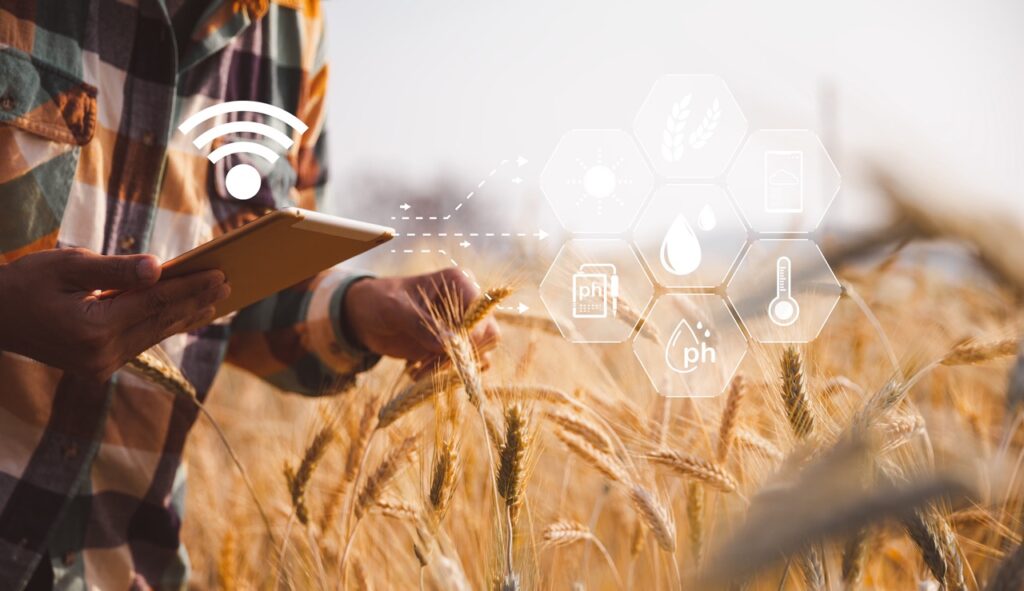SCADA + Satellite Equals Industry’s Latest Power Couple

When it comes to remote industrial operations, there’s only one constant, and that is change. Change can occur in an instant — a burst pipe, an equipment malfunction, a flash flood. But, more often, change creeps up slowly and then suddenly looms large. Take, for example, the worsening labor shortage. Nowadays, if something does go wrong in the field, you might be hard-pressed to find someone to go out and fix it without leaving a gaping hole in another part of your operations. Changes give way to more changes, but they also give rise to certainties. For instance, industries with large-scale remote operations know that automating equipment and functions — and monitoring those automated systems from afar — is imperative in today’s world, where resources are short yet production demands are a tall order to fill. That’s one reason why the global industrial internet of things (IIoT) market size is projected to reach a staggering $1,683.30 trillion by 2030, up from last year’s value of $321.81 billion, according to a market analysis by Grand View Research. It’s also certain that, in some respects, the more things change, the more they stay the same. As digital transformation across various industries kicks into high gear, Supervisory Control and Data Acquisition (SCADA) — a decades-old but highly implemented technology heavily used by oil and gas, water treatment, energy and manufacturing — is adapting to meet the demands of the modern industry, proving it’s not going anywhere anytime soon. And that brings us to another certainty that still comes as a surprise to some SCADA users: Satellite connectivity has emerged as one of the fastest, most reliable, and most secure methods of transferring data from remote IIoT devices to existing SCADA systems. Today’s satellite systems are easy and inexpensive to deploy, and they make IIoT technology easier to scale. Space, it turns out, is the next new frontier for industrial leaders. During “McKinsey and the World Economic Forum 2023,” futurists predicted the space market to reach $1 trillion in the next decade with the number of satellites tripling during that time. While quick to acknowledge and adapt to changes that affect day-to-day operations and key performance indicators, SCADA users by and large have not been early adopters of satellite technology over the past decade, in part because of its historic reputation of being pricey, having high latency, and providing limited bandwidth. The world of satellite has changed. And FreeWave is stepping up to play matchmaker. We’re building an evolutionary path toward an end-to-end solution (more on that in a bit). Reliable, consistent connectivity is key. FreeWave is a Global Authorized Reseller of ORBCOMM and a Connectivity Wholesale Partner in Viasat’s ELEVATE program (Viasat, headquartered in Carlsbad, California, just completed its acquisition of London-based Inmarsat). It’s time, in the midst of the Fourth Industrial Revolution, for one of industry’s long-standing staples, SCADA, to join forces with modern industry’s rising star — satellite connectivity. Satellite Adoption’s Meteoric Rise How can companies be certain that satellite is the future-proof connectivity solution for remote operations? Follow the money. Satellite IIoT revenue is expected to surpass $130 million by 2032 in North America alone, according to Viasat. Globally, the compounded annual growth rate in that time span is estimated at 27 percent. By sector, the oil and gas (O&G) industry leads the pack, with satellite IIoT investment more than doubling over the next decade to about $115 million worldwide in 2032. Smart agriculture, transportation and mining also are pack leaders, with the utilities industry not far behind. Growth might accelerate even faster were it not for the persistence of outmoded notions about satellite communications. When they think of satellite, some corporate decision makers picture a dish as wide as an above-ground swimming pool that costs about $5,000 just to set up, plus $500 to $1,000 a month to operate. But that’s like judging a job candidate based on his 10-year-old paper résumé instead of his up-to-date LinkedIn profile. It’s true that satellite communications were relatively slow and clunky a decade ago, but satellites these days can be as small as a petri dish and cost as little as $500, with monthly service available for as low as $30. Companies with remote operations have relied mostly on cellular connectivity and other terrestrial solutions to transmit remote data to their SCADA networks. But as IIoT continues its push into underserved locations — from remote grazing pastures in Wyoming to rugged open-pit lithium mines in Western Australia — satellite offers distinct advantages. Going back to our earlier example of a burst pipe, equipment malfunction or unexpected weather crisis – that is all too common for remote industrial operators – satellite provides reliable and real-time connectivity. Here’s why this is important. In sparsely populated or harsh environments, cellular service might be limited, spotty, or altogether unavailable. In especially isolated areas, where a cell tower sighting is about as likely as a Yeti sighting (not the outdoor product goods, but the fabled ape-like creature), satellite connectivity may be the only viable solution for monitoring SCADA equipment. Where cellular coverage is available, sensor data travels wirelessly from tower to tower until it reaches the SCADA master station. Along the way, landscape features like mountains, buildings, and even clumps of trees can interfere with transmission. For this reason, satellite is a great “insurance policy” for remote connectivity that needs continuous uptime. By contrast, satellite communication does not depend on land-based transmission, so landscape features won’t block the signal. Data travels from sensors to a satellite in space and bounces back to the master station without interference except for extreme weather events that can sometimes cause a signal delay commonly called “rain fade.” FreeWave and its partners have an answer for that. With the acquisition of Inmarsat, Viasat’s fleet provides full global coverage via 19 satellites in space spanning the Ka-, S-, and L-bands. L-band signals can penetrate through rain, snow, and other inclement weather, so signal reduction is not an issue. L-band communication also offers
3 Customer Impacts for Satellite Connectivity from Viasat’s ELEVATE Partner Event
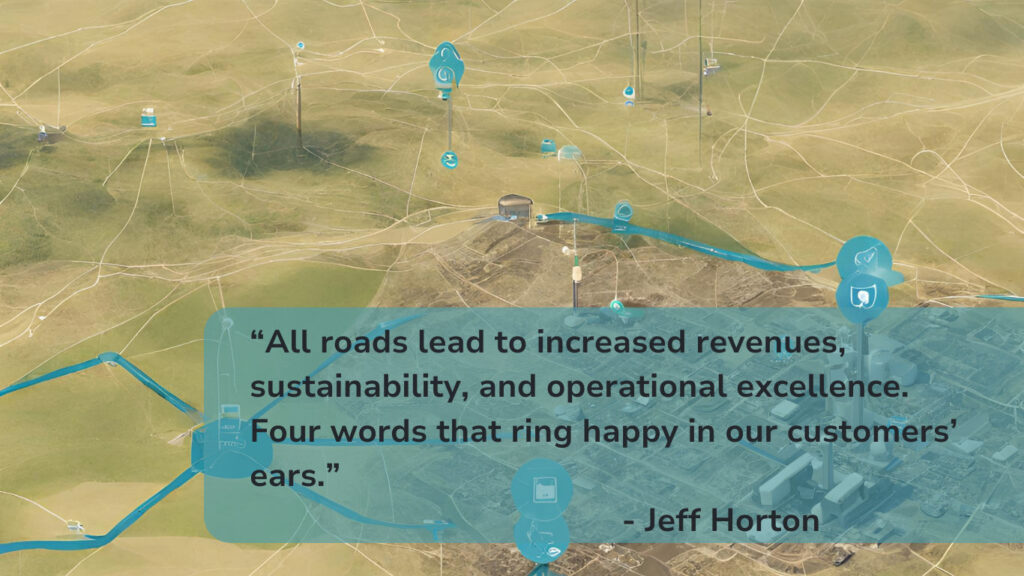
With a plate of bangers and mash in front of me and a bank of windows, I marveled at the views. We were on the 40th floor of Duck & Waffle, with a bird’s eye view of Buckingham Palace, the Tower of London, London Bridge, and Wembley Stadium. We were at the epicenter of everything British. I visited none of these places. Instead, I experienced something even better: a front row seat into the dramatic impact satellite connectivity is defining success for industrial companies. The Viasat ELEVATE Partner Event was the first of its kind. Tech innovators from around the world gathered to learn and share stories about how satellite is transforming communications for remote operators in oil and gas, agriculture, mining, logistics, and more. Viasat’s ELERA coverage map Beyond the event, ELEVATE is also a partner program to ramp up the IoT ecosystem through education, collaboration, and idea-sharing for IoT solution providers like FreeWave, system integrators, machinery manufacturers, and OEMs. Viasat is a global company of more than 8,000, a rising Fortune 1000 enterprise, which acquired UK-based Inmarsat in early 2023. Viasat covers 99% of the U.S. with Inmarsat’s ELERA satellite network providing satellite access to many parts of the world using the reliable and weather-resistant L-band network. Together, they are driving new terminal development, lowering the cost of satellite connectivity, and speeding up real-time, two-way information for remote operators who previously felt satellite communication was cumbersome, expensive, and slow. And it was. But that’s the old story. That’s why I’m excited to share three themes that emerged for me during our visit across the pond. 1. Radical innovation is driving IoT adoption in new markets and lowering the cost threshold. Here’s a non-scientific way of summing up the first theme: there’s a whole lot of R&D going on in the world! Viasat has 19 satellites in orbit with 11 on order. Impressive. They are investing in teleports for the L-band network, undeniably the best spectrum for data transfer over satellite. Translation for the rest of us? Mobile satellite communication became 20x faster in Q1 of this year. Using the same terminals with new software, this means you can send data more efficiently and more affordably. Spectral efficiency will exponentially increase the functionality of IoT devices for many solutions. Technology, and specifically data, only has meaning when people use it to better their lives. Earlier this year, as part of our 30th Anniversary vision for the future, FreeWave recommitted to not only building great tech, but to understand our customers’ day-to-day needs, tech stack outlook, revenue goals, challenges, and business vision. We talked to hundreds of customers, beta testers, and potential customers. At the top of their list: zero trust security, compliance monitoring, a leaner tech stack, real-time connectivity, remarkably better operational performance, and cost effectiveness. This is why we went to ELEVATE: to keep delivering on that wish list. And while we may have missed the sights of London, we saw our collaboration with other partners as being like a pit crew for remote industrial companies in hard-to-reach places. One company, for example, has reduced video compression by 80%. This is a game-changer for a rancher with thousands of acres because while sensors might show how much water is in a tank, ranchers are spending 100K a year to see their cattle. With video compression integrated into FreeWave solutions, they can save time and money on truck rolls. Many applications, from homeland security to smart oilfields to refrigerated cargo on a ship, can benefit from this. With the progression of satellite reliability, we’re excited to be able to bring solutions that include data-intensive video streaming requiring IP cameras. We’re designing solutions for a customer installing electric fences around government and private campuses. New IoT tech tied to satellite defies the myth that we can’t be everywhere all the time. Turns out we can. 2. Channel partners are not afraid to build things, together. The ROI of mobile satellite communication is really impressive when you are able to enhance production, throughput, and safety. Fearlessly building things together, for the betterment of our collective customers, is definitely a second theme we took away from the event. Companies we align with have deep roots in specific technologies: push-to-talk, remote employee safety, cameras, backhauling unmanned vehicles for government, just to name a few. Bringing complementary pieces into our portfolio solves customers’ bigger problems. Attending ELEVATE signaled the dawn of a new age where technology is amplified by software, satellite terminals, and collaboration of many great minds thinking together. In the end, we are made better together as channel partners, leveraging strengths, knowledge, and abilities. It makes us better, faster, stronger. It makes us better for our customers. That’s our goal as an innovator. 3. Satellite aligns with a more sustainable future. While Sputnik, the first satellite, was launched in 1957, I feel like the Space Age is just beginning here on earth. It is a key part of a more sustainable future. In an article in SpaceRef, Inmarsat’s President Mike Carter put it this way: “The ELEVATE community will play an active role in addressing the planet’s really big challenges, helping build a more sustainable, efficient, and safe global supply chain.” After experiencing ELEVATE, I’m a believer. Here’s why. If you can get real-time data remotely, you’re not burning fossil fuels to gather insight. If there is machine-to-machine “dialogue,” you streamline people’s time. If you let the ground reveal what a sprayer needs to know, you might use water more efficiently. The role of satellite communication helps solve today’s critical issues. Increasing yield and output without increasing the percentage of cost keeps consumer goods affordable. Making lives and work better is what IoT is about. It’s what FreeWave is about. Helping make lives better has been a core belief of ours for decades. FreeWave’s Platform-as-a-Service Brings Remote Operators Closer to the Truth We’re not alone. For me, that was the big takeaway from Viasat’s ELEVATE. We have access to many different ELEVATE partners and their technology superpowers. These will help us bring to market
Shedding New Light on Industrial Solar Power System Performance
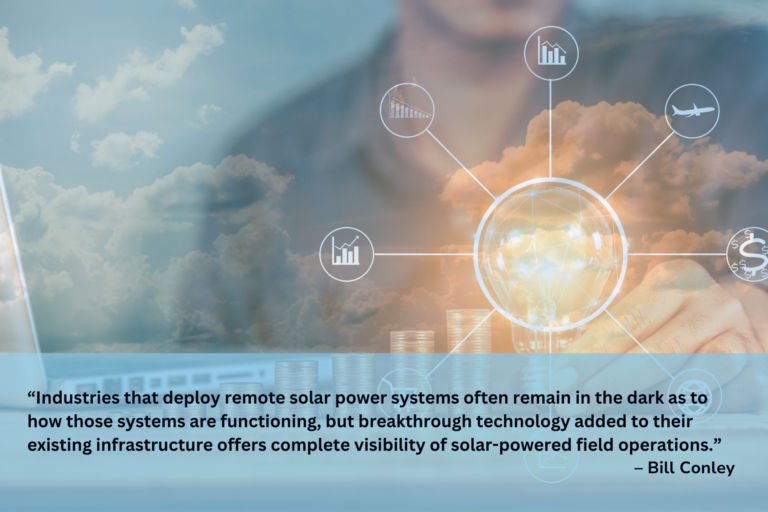
It’s not easy to write about solar energy without getting carried away with metaphors. In a world facing a worsening climate crisis, solar power — as a renewable energy source — represents a ray of hope, a bright spot, a beacon of light. Solar power’s day in the sun has been a long time coming. Before he died in 1931, inventor Thomas Edison reportedly told friends, “We are like tenant farmers, chopping down the fence around our house for fuel, when we should be using nature’s inexhaustible sources of energy — sun, wind, and tide. … I’d put my money on the sun and solar energy. What a source of power!” Today, many diverse industries are putting their money on solar power. But, in many cases, it’s not a sense of urgency about “going green” that drives them. In industries operating in farflung, remote locations, the use of solar power is usually driven by pure necessity — there’s simply no other viable power source. While there’s excitement around the promise of solar energy, my conversations with industry leaders often center on the problems associated with remote solar power systems, including a lack of visibility around solar-powered battery performance. Since battery failure can cause safety hazards and even halt production, operators take extreme — and expensive — measures to prevent it. Our customers’ pain points led to the development of a breakthrough, all-in-one-box solution that can be easily added to existing infrastructure to slash maintenance costs and reduce risk factors by providing critical data on remote solar power system performance. I invented this technology, but before I tell you all about my “baby,” let’s look more closely at the pain points it helps to address and the cost savings and other benefits it provides. Eliminating the Guesswork Around Solar-powered Battery Performance While solar-powered devices reliably monitor field operations as a whole, a lack of visibility around the performance of the solar-powered batteries themselves is a huge blind spot and cost driver. Oil and Gas (O&G), wastewater management, and utilities are among the major industries that rely on solar power, principally to operate remote sensors and devices that send critical information back to a centrally located SCADA system. This data tells the SCADA operator what’s going on in the field. For example, O&G personnel are alerted if equipment goes down or if various pressures and temperatures reach unsafe levels. Powering the devices that relay this information depends on reliable battery performance, which, in turn, depends on the availability of sunlight to power the batteries. Touting the pros of solar power, Elon Musk famously said the sun “shows up every day” and “just works.” In reality, the sun doesn’t always shine sufficiently to fully charge solar batteries, and, as we all know, it clocks out every night without fail. So, operators have tried to optimize battery performance by doing calculations to determine the amount of current needed to power the devices, including an estimate of autonomy time — the number of days that a battery charge will last should the solar panels stop absorbing sunlight. While these calculations initially suggest which sizes and configurations of solar panel and battery systems are needed to produce the required current, they don’t take into account equipment deterioration over time or the power requirements of any equipment added down the line. Hours of autonomy, so painstakingly calculated in what amounts to a paper exercise, are also affected by extreme ambient temperatures and other conditions. To avoid power disruptions and production downtime, O&G producers have taken to replacing all of the batteries every six months, regardless of need or individual battery performance. It’s not uncommon for a major producer to have several thousand remote, solar-powered sites, so battery storage and replacement are substantial budget items. One major producer mentioned they spend $1.4 million annually — just on batteries. Callouts and lockups are also expensive — and less predictable. A callout occurs when a system goes offline and stops sending SCADA communications, triggering a truck roll to the site to determine the cause. Equipment lockups require technicians to drive to the site to power-cycle the affected assets no matter where that site is, all for a process that takes 20 seconds to perform, sandwiched between hours of drive time. Considering that each and every truck roll costs as much as $2,400, eliminating set-schedule battery replacements, manual power cycling, and most service calls could easily save millions of dollars. So, let’s talk about the solution. Introducing Solar Site Analytics Having collaborated with customers to understand the problems and limitations they were experiencing with solar-powered operations, we developed a patent-pending solution that provides complete visibility of solar-powered field operations, along with other essential features. Contained in one compact box, the product packs smart monitoring and analytics capabilities that prevent production losses, reduce labor costs, improve worker safety, and predict power system degradation or failure, including: Accurate hours-of-autonomy calculations in real time Real-time updates on battery and solar panel sizing requirements for maximum efficiency Battery capacity levels, which indicate when a battery actually needs to be replaced Automatic power cycling in the event of a lockup Analytics that detect anomalies and predict maintenance needs before solar power system components go down Automatic load shedding and load prioritization to protect batteries from excess voltage As an added feature, it also includes a maximum power point tracking (MPPT) charge controller — the most efficient controller for industrial solar power system applications The product can connect to a customer’s existing SCADA system or connect directly to the FreeWave cloud-based data analytics platform. With it, operators can monitor temperatures, pressures, and other metrics, along with battery and solar panel status and performance — from capacity levels and days of autonomy to predictive maintenance forecasts. FreeWave’s patent-pending remote solar power system manager has been in development for years and, in nearly a decade of field testing, not one instance of critical failure to monitored system components has been reported. And, the monitor offers a swift return on investment, paying for
A Story Three Decades in the Making
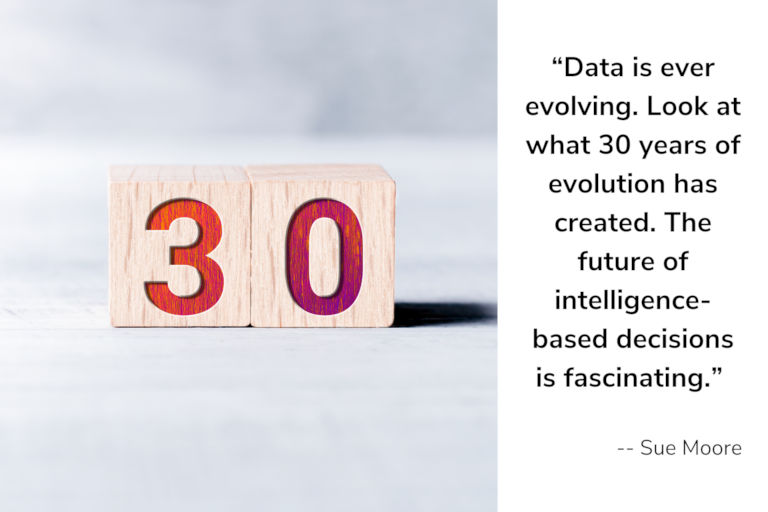
Milestone birthday alert. FreeWave turns 30 in 2023 and I’d like to take you on a journey of data over the last three decades – taking a look at where data has been and its sci-fi-like role in our future. Since FreeWave is all about transforming data into real knowledge for real people, I drew from a broader perspective about the bits and bytes of the data of life. The ideas here are inspired by FreeWave’s innovation team. From a serial inventor to our founder, each has shaped the field of technology in their own right. Sure, the first time someone uttered the words “big data” (October 1997, in case you’re curious) is interesting, but how has the term itself changed the way we live and work? As Steve Jobs said: “You can’t connect the dots looking forward; you can only connect them looking backwards.” Thus, this is more taking stock of data’s backstory over a cold IPA than a mundane timeline. Thirty candles on the cake commands a little self-reflection. The wild days of our youth are behind us. We’re all grown up now, and while data may be following its own trajectory, the parallels are pretty fascinating. I start where all great stories begin. My “why.” I grew up in the Midwest where a lot of the technology that we use today was born and innovation spans generations. I remember “playing office” with with my father’s paperwork at home (I guess remote offices were a thing, back in the day). He worked at Motorola (a company I would later join) for decades. He was a regional sales rep during the the early 80s when he was on special assignment, working on this thing called “cellular.” His company car’s trunk was filled with black boxes – and there was even a phone mounted in the center column between the front seats. It was cool to use. I thought I was cool for being able to use it. So, I was hooked, not only on technology, but the data seemingly flying there and there to make that all possible. From there, I guess I just followed in Dad’s footprints, although I chose a marketing path, and 40 some years later, here I am, still watching technology expand. Still fascinated by how those ones and zeroes are writing the world’s story. It’s 1993: Do You Know Where Your Floppy Disks Are? The year is 1993. Bill Clinton is president, Beanie Babies have hit the market, Intel has introduced the Pentium microprocessor, and 3½ inch floppy disks in bright colors are scattered across desks (unlike its austere sibling, the silver compact disk). In a small office somewhere in Boulder, Colorado, the FreeWave cofounders are meeting with a couple of ladies who make dreamcatchers. FreeWave was born among the likely stacks of floppies used to store code for FreeWave products to come. And, we can’t forget that the then new Colorado Rockies threw out its first pitch in the National League West (to date, we have never won our division – but, boy, we’ve got great mountain views!). “When we first started, wireless was used in many applications, but not to anywhere near the extent it is today. The early applications for our products were the precursor to IIoT (Industrial Internet of Things) and showed how important data was,” says Steve Wulchin, CEO and cofounder of FreeWave. After earning his MBA at the University of Texas, Steve was hired by Hewlett Packard. His first desktop computer at HP had a 5MB hard drive (yes, megabytes!). Cell phones and the internet didn’t exist, and Apple was a company that was pretty much left for dead by the rest of the tech world. That, he says, is the cool thing about technology. “Look at where we are now,” he says. “We may not have flying cars, but we do have a lot of unbelievable things that few could have imagined back then.” Like technology, life has its own twists and turns. “I never planned to move to Houston post-college, never planned to get an MBA, and absolutely never planned to start a company,” says Steve. Yet, he did. FreeWave has come a long way and is now innovating around end-to-end solutions so companies better understand operational, performance, and revenue opportunities through their data. Also from the 90s, computer scientist Michael Lesk writes: “There may be a few thousand petabytes of information all told.” (IDC predicts the global datasphere will reach 175 Zettabytes by 2025.) Using data as insight also saw the light of day. In 1993, digital mobile phones went from analog to digital, giving way to applications, data transfer, and mobile hotspots. In 1995, M2M began using cellular as a backhaul solution. And in 1999, SMS pricing and data plans fell to affordable rates. Things, the Rise of Data in the Aughts and the Value of Insight Once people realized Y2K (for zoomers, this was the potential crash of computers on December 31, 1999) was a non-issue, the world was off and running. We snapped photos with our phones, put our taxes on flash drives, carried a thousand songs in our pocket, and connected on Facebook. During the 2000s, “things” like washing machines were predicted to connect to the internet and order detergent. So far, most of us are still putting Tide on the grocery list. However, IoT has indeed given rise to a tsunami of data. According to the IoT Analytics “State of IoT—Spring 2023” report, the number of global IoT connections grew by 18% in 2022 to 14.3 billion active IoT endpoints. In 2023, the global number of connected IoT devices is predicted to grow another 16%, to 16.7 billion active endpoints. In the plainspoken world of marketing where I play, a “billion active endpoints” is a lot of data flowing through a lot of connected things. The term “big data” was first used at an IEEE conference on visualization in 1997. Michael Cox and David Ellsworth authored “Application-Controlled Demand Paging for Out-of-Core Visualization,” stating: “Visualization provides
The Whats and Hows of the Ultimate Dashboard for Industrial IoT
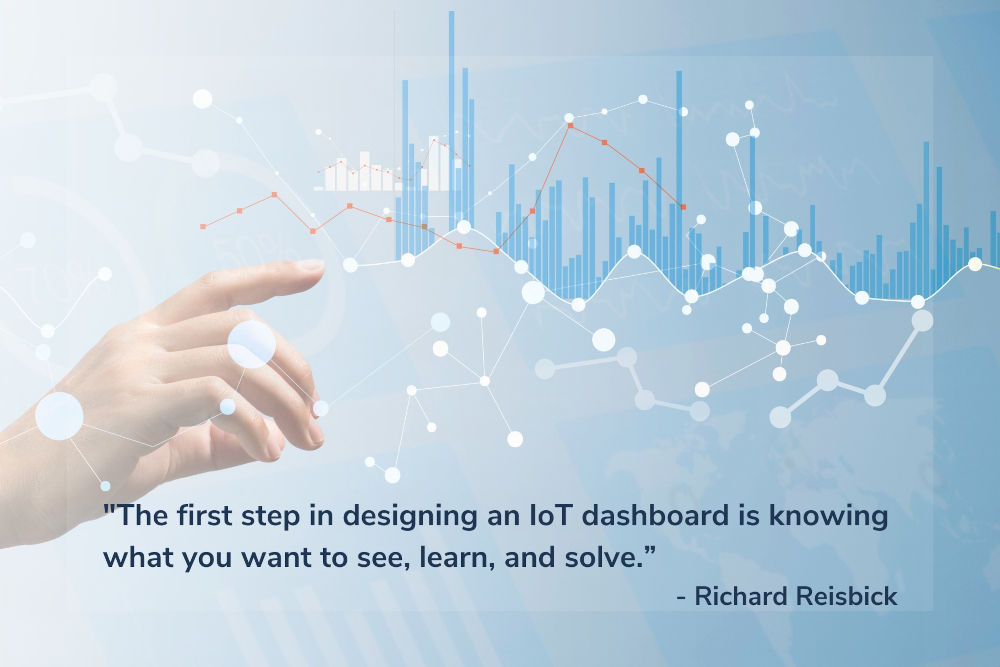
If you use the internet of things (IoT) devices to monitor or automate certain business operations, you may be wondering what to make of all the data those devices generate. Collectively, IoT devices across the globe will generate almost 80 zettabytes of data by 2025, according to International Data Corporation (IDC) projections. A zettabyte equals a trillion gigabytes. In layman’s terms, we’re talking about oodles and scads and gobs of data. At the business level, data collected from IoT-enabled devices could conceivably be entered into a spreadsheet, but data presented in this manner becomes overwhelming and even incomprehensible. A much better way to store and make sense of your data comes in the form of an IoT dashboard, which visually represents relevant data in such a way that you gain at-a-glance, actionable insights regarding your operations. An effective IoT dashboard allows you to make data-driven decisions to optimize efficiencies, troubleshoot problems, and make other adjustments and improvements that could potentially impact profit margins. Dashboard Design and the KISS Principle — Keep it Simple, Stupid Think about the dashboard display in your car. It doesn’t show you everything there is to know about the vehicle. Imagine how overwhelmed and distracted you would feel if it presented you with minutiae such as the condition of your tire tread, how many cubic inches of trunk space you’re using, the precise amount of antifreeze you have, the decibel level you top out at when singing along with the radio, and so on, ad nauseam. All this information crammed onto your dashboard would make it difficult for you to drive and make important, time-sensitive decisions, like when to stop for gas. That’s why the dashboard display is limited to what you need to know to drive safely and efficiently: How much fuel do you have? How fast are you going? How many miles per gallon are you getting? A well-designed IoT dashboard also only shows you data that you’ve prioritized in accordance with your business objectives, with the ability to pull up additional data points as desired. A well-designed dashboard prompts you to a view of data sets that you can select, creating an unfussy, easy to understand, and up-to-the-minute snapshot of in-field device and system-level performance. Effective Dashboard Design — It All Starts with You When it comes to selecting the best IoT dashboard for your organization, the first step is to define your business goals. Before requesting demos or engaging an IoT dashboard vendor, identify what you want to learn and achieve with the data you collect. Your business goals will determine the dashboard design you choose, as well as the type of data and performance indicators you need to track to meet your goals. For example, if your business goal is to improve the efficiency of your manufacturing process, you might want to track equipment downtime, production output, and raw material usage. Another scenario might be an oil and gas company wanting to track performance by optimizing existing wells, improving oil recovery, and minimizing its carbon footprint or emissions. Having defined your business goals, you can then determine which metrics matter most and how best to display them to facilitate decision making. Then, you can look for a dashboard that has the necessary features and functionalities to help you meet your business objectives. Dashboard Deliverables — What You Should Look for When Evaluating Your Options IDC estimates there will be 55.7 billion connected IoT devices by 2025. The IoT dashboard and platform market, though still quite young, is growing exponentially. With an ever-increasing number of options, choosing which vendor and product will best support your business goals can be as easy as working with a leading IoT network provider. We will discuss what to look for when considering your options, after a brief clarification of terms. You may hear the words dashboard and platform used interchangeably, so think of the dashboard as the user interface within an IoT platform that allows you to interact with your connected devices. The dashboard is both a control panel and a visual representation of key data your IoT devices collect. The platform is the dashboard’s pre-built foundation. Platform-based dashboards are typically more practical than out-of-the-box dashboard solutions, provided the platform is well-engineered. And a well-built platform is, first and foremost, generic. A Solid Generic Framework with Customizable Features and Functionalities In the case of information technology platforms, “generic,” ironically, is a positive descriptor, synonymous with user-friendliness and adaptability. Generic IoT platforms allow for customization, and FreeWave’s data platform comes with an array of templates and widgets that allow you to create a custom dashboard almost as easily as snapping together those beloved Lego® building blocks from your youth. The lesson here is the less “generic” the platform, the greater the likelihood you’ll need to hire someone to configure your initial dashboard and reconfigure it time and again as your business strategy evolves. Effective dashboards are intuitive and interactive. They are not a data dump, but rather convey information hierarchically through charts and other data visualizations, enabling you to extract actionable insights, receive alerts, identify patterns and trends, make projections, and run various scenarios with the aid of built-in analytics and machine learning. If you want to dive deeper into your data, interactive drill-down and click-to-filter features guide you through multilayer displays. You by no means have to be a programmer to design an effective IoT dashboard, but if you need a little extra assistance, look to an IoT platform provider for help. As a convenience to customers, FreeWave is enhancing its distribution network with specialists trained to assist in defining your user interface, in accordance with your business goals. Decision-making Support Through Data Storytelling Designing an industrial IoT dashboard begins by defining what data you want to see and why. It’s an involved process, but the end result should be a simple data story, with key takeaways highlighted. Once you’ve created your ultimate IoT dashboard, you’ll gain a competitive edge for your organization as the intelligence embedded
IoT and the Carbon Market: How Data Can Help Drive Decarbonization
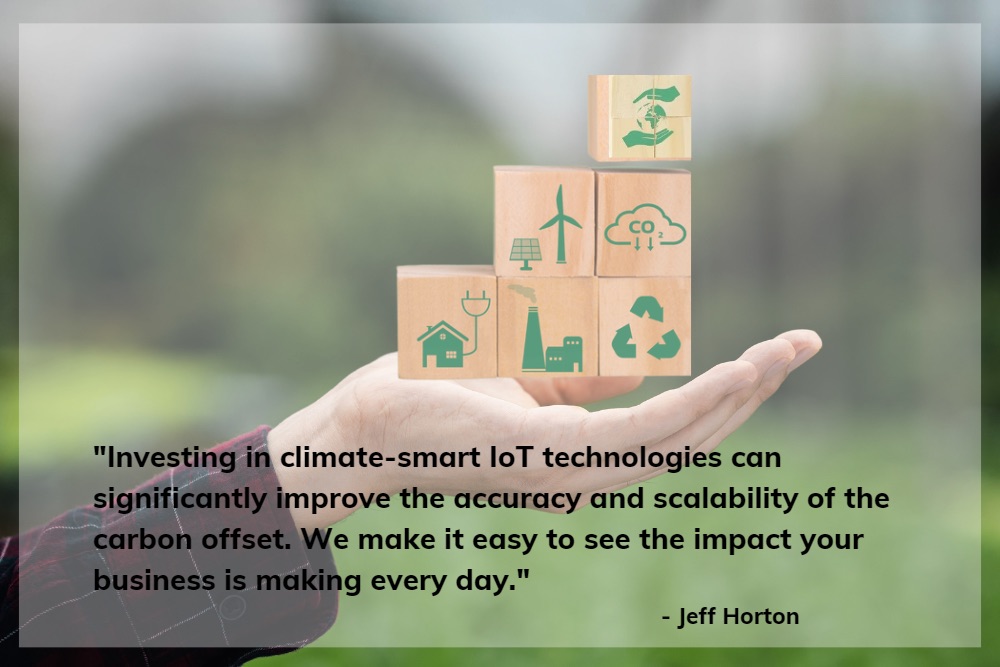
Let’s set the stage for what greenhouse gasses are by using a familiar scenario. You’re walking in a greenhouse. That warm, damp air that you feel on your skin and the additional sunlight that warms the space likens it to a 24/7 hot yoga session for plants. That, in a simple example, is the greenhouse gas effect. Now, take that greenhouse and expand it to the size of the planet. Imagine the world as one large terrarium with man-made greenhouse gasses (GHGs) trapping heat in the atmosphere. The impact, according to the United Nations Environment Programme (UNEP) Emissions Gap Report, is measurable and critically damaging to life on planet earth. Global temperatures are expected to rise at least 2.7C this century. The report goes on to say that GHGs need to be halved by 2030 to avoid a climate catastrophe. According to the Environmental Protection Agency (EPA), one of the leading GHGs is carbon dioxide (CO2), which accounts for 79% of all GHGs from human activities. Reducing CO2 (or decarbonization) is critical. The EPA points out that carbon emissions alter climate patterns and that “human health, agriculture, water resources, forests, wildlife, and coastal areas are all vulnerable to climate change.” Fortunately, data available from Internet of Things (IoT) technology can help accelerate decarbonization efforts as explained, in part, below. The Intersection of IoT and Carbon Markets As the world faces the challenge of reducing GHG emissions, industries are turning to regulated carbon credit markets and voluntary carbon offset markets to help them shrink their carbon footprints. Carbon markets — where carbon credits and offsets are sold and bought, similar to commodity futures like grain — provide a way for industries to compensate for unavoidable emissions by investing in certified projects that reduce or remove carbon dioxide from the atmosphere. These projects mitigate the environmental impacts of industrial operations while helping organizations work toward net-zero commitments and environmental, social, and governance (ESG) reporting goals. Carbon credit markets create accountability. Along with international pacts to drastically lower GHG emissions, consumer demand to reduce environmental harm is spurring carbon market growth. This demand is driven by deep-seated concerns that are literally keeping Americans up at night. A new survey from the American Academy of Sleep Medicine (AASM) reveals that one-third of adults (32%) “always or often” lose sleep due to worries about environmental issues. Investing in carbon offset projects shows that an organization’s commitment to combat climate change goes beyond lip service. A worldwide awareness of climate change could be one reason companies are taking note. The voluntary carbon market recently exceeded $1 billion in global value and could surpass $30 billion in annual value by the end of the decade, according to a Bain & Company report. While investments are clearly on the rise, “the carbon market has reached a crossroads,” the report states. That’s because carbon markets today are built largely on trust — and as it turns out, that trust is tenuous. Enter the critical role of data. Verification methods for carbon offsetting lack uniformity, which raises uncertainties about the fair market value of credits as well as doubts about the efficacy of the projects they fund. As a result, many organizations that need carbon offsets to meet their net-zero commitments have nevertheless chosen not to buy them. For carbon markets to achieve their potential, reliable emissions measurements and data are needed for valuation and verification. “Zero Trust” Begets Absolute Trust Leveraging IoT technology consisting of sensors, network configurations, and cloud-based analytics can significantly improve the accuracy, reliability, and scalability of the carbon offset verification process. That’s where FreeWave comes in and its partnership with Inmarsat to provide global coverage, collecting IoT sensor data from anywhere and transporting it to the cloud for analysis and action. The FreeWave platform has reputable third-party auditors who analyze data to confirm the efficacy of certified carbon offsetting projects. For example, in a reforestation project, auditors can accurately measure and convey to offset buyers how much carbon is being sequestered, and it won’t be long before buyers, through a dashboard, can track these measurements themselves and compare them against a projected scenario of how many tons of carbon emissions would have occurred were it not for the project. Using incontrovertible metrics to assess project performance increases investor confidence, while sellers can ensure that their credits are backed by measurable emissions reductions. This could ultimately help move the voluntary carbon market toward a more transparent, zero-trust model. When there’s absolute trust in carbon market performance, the value of carbon offsets will increase. That’s good news for industries like smart agriculture that can potentially capture more carbon than they produce, enabling them to sell offsets as an additional revenue stream. Beyond Carbon Markets — Sustainability Best Practices Carbon offsetting is part of a holistic sustainability plan that starts with reducing the use of fossil fuels and pollutants, taking carbon reduction efforts as far as possible before offsetting any remaining emissions. Here, too, IoT and FreeWave come into play, deploying technologies that improve operational efficiency while protecting and conserving natural resources. Growers, for example, can use sensor data to optimize efficiency for irrigation and fertilization programs. IoT data allows agriculture and other industries to monitor and manage their environmental impact. It also gives them data-based ESG impact reports that they can use to their competitive advantage — and to discredit accusations of greenwashing (exaggerated claims of environmental practices). Most business leaders (76 percent) in major industries doubt their peers’ ESG reporting, according to recent research by satellite solutions provider Inmarsat. Beyond the environmental and humanitarian imperatives, investing in climate-smart IoT technologies can be part of a long-term revenue enhancement strategy. We at FreeWave believe that products that are verifiably carbon-neutral will warrant premium pricing in the eyes of environmentally conscious consumers, just as produce grown organically commands a higher price. The Journey to Net-Zero Most business leaders believe that data collected via IoT solutions is critical to building trust (81 percent) and improving ESG outcomes overall
Satellite Connectivity Becomes Next-Generation Tech for Remote Operations
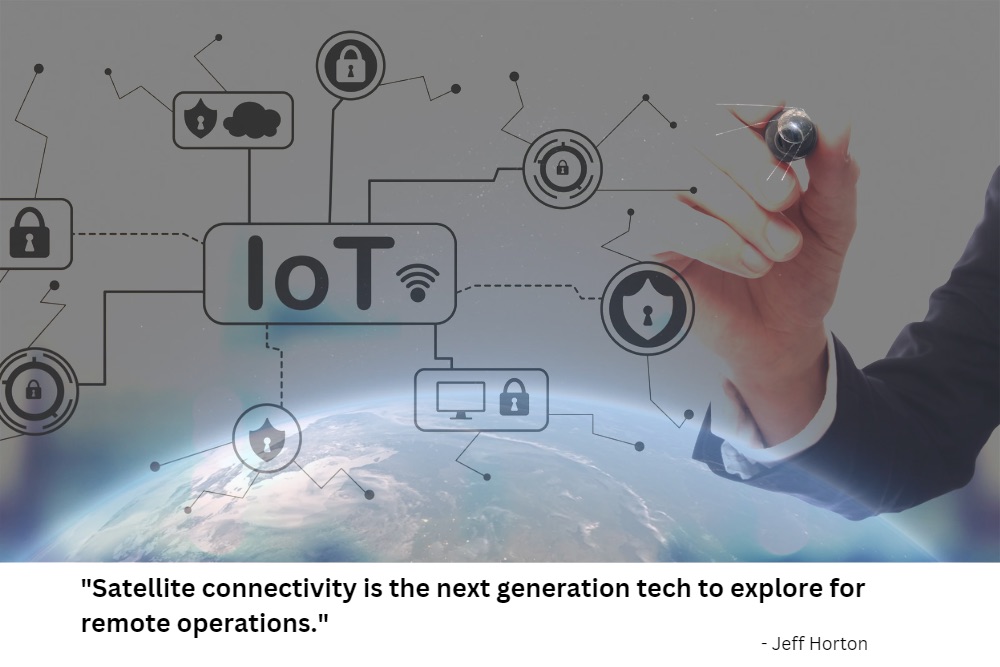
The future of IIoT connectivity is up in the air — literally. Space is the new frontier for IIoT connectivity, as satellite connectivity is fast becoming the networking solution of choice for many industrial use cases. IIoT, or the industrial internet of things, refers to an ever-expanding ecosystem of sensors, networking equipment, and analytics, which work together to collect, transmit, and analyze data from “things” used in industrial operations. Data transmissions from industrial assets help guide business decisions or automatically trigger actions. For example, in agriculture, IIoT-enabled irrigation systems monitor soil moisture levels, weather forecasts, and other data points to help growers determine the best time to water, or the IIoT solution can automatically activate sprinklers without human intervention if programmed to do so. When talking about satellite, this two-way communication reveals the next-generation tech for remote operations. First, though, let’s take a quick glance back. What Satellite Connectivity Means for People in Remote Areas FreeWave started by helping customers transmit mission-critical data using radio technology in 1993. We’ve seen the evolution of communications since then, with not only our rugged wireless radios continuing to serve the future of the oil and gas industry, but also the advancement of satellite for people leading remote operations. Traditionally, IIoT has mostly relied on cellular connectivity and other terrestrial solutions for data transmission, but as IIoT continues its push into underserved locations — from remote grazing pastures in Colorado to offshore oil platforms in the Pacific Ocean — cellular solutions pose some serious limitations. Connecting people, not things, is the foundational purpose of cellular infrastructure development, so in sparsely populated or remote areas, cellular service may be limited or even surprisingly unavailable. While other non-cellular connectivity solutions exist, for certain circumstances, satellite is becoming a more viable solution, offering distinct advantages. Competition is driving rapid innovation in the IIoT satellite space even as it drives down costs. As a result, companies that previously encountered lack-of-coverage or cost barriers with the various terrestrial networking options now have an affordable IIoT connectivity solution in the form of satellite — with cost savings between four and 20 times what they once might have paid. Satellite connections are, by definition, wireless and don’t require remote operators to install fixed lines — DSL lines or coaxial cable — for data transmission. This added flexibility gives companies the freedom to scale their IIoT applications quickly and easily as their needs and business goals evolve. For example, a major agriculture company with an expanding customer base in remote parts of Brazil, Argentina, and Chile announced it will use satellite connectivity to operate autonomously driven tractors in those countries. In these remote areas with no cellular or Wi-Fi coverage, real-time communication through satellite connectivity allows farmers to stop and start the tractors and other unmanned equipment, monitor the equipment’s performance, and determine what to do when a tractor encounters an obstacle — all through an app-based control panel from afar. Meet LEO and GEO Not all satellites are created equal, however. There are three common satellite types: Low Earth Orbit (LEO) satellites, Medium Earth Orbit (MEO) satellites, and Geostationary Equatorial Orbit (GEO) satellites. LEO and GEO represent the two altitudinal extremes and are most commonly used for IIoT connectivity. LEO satellites are smaller and orbit closer to the earth, so launching them is less expensive. LEO satellites circle the earth several times a day, so multiples are needed to fly in succession over the target geographic area in order to provide consistent coverage and avoid dataflow disruptions. The ground equipment needed to monitor and maintain LEO satellite constellations is also extensive. GEO satellites — a type of geosynchronous orbit (GSO) satellite — also orbit the earth, but they do so along the equator in the same direction and at the same rate the earth is spinning. Hence, from our vantage point, a GEO satellite looks like it’s standing still since it is always above the same location. Its daily orbit notwithstanding, a GEO satellite, for all intents and purposes, stays “parked” above the area that needs coverage. Since GEO satellites are continuously visible, ground station tracking is not required, and their greater height offers substantially more geographic coverage; in fact, only three GEO satellites can provide whole-earth coverage. LEO satellites and GEO satellites both have their place in IIoT connectivity. With less distance for signals to travel, LEO satellite solutions historically have offered lower latency rates and higher bandwidth capabilities, although newer GEO satellite solutions offer these capabilities now, as well, with a signal-bounce delay of about one-quarter of a second. The end user’s needs, business goals, and budget will determine which IIoT satellite solution is best. We’re seeing an increasing need for two key requirements for satellite connectivity — real-time or near real-time data transmission and two-way communications. Can Satellite Connectivity for Remote Operations Minimize the Impact of Catastrophes? Environmental catastrophes happen more frequently than we are even aware. Being able to positively impact a critical issue before it happens is certainly the goal of many. IIoT and its network-connected sensors and dataflow provides the catalyst for alarming and alerting to help alleviate the impacts of disastrous situations whether they be natural phenomenon, human error, or otherwise created. FreeWave has expanded our footprint in the environmental space, helping customers deploy early-detection IIoT sensors that alert the appropriate personnel in the event of a disaster. Let’s take the case of a timber company using sensors to detect lightning strikes or approaching wildfires. Strategically placed sensors are programmed to detect various gas profiles indicative of those events. A delayed alert could spell disaster, so real-time notifications are of paramount importance. The same is true for oil and gas companies that receive alerts before a catastrophic equipment malfunction—real-time alerts to what’s happening in the field could save millions of dollars and prevent environmental devastation and other ramifications. One-way and Two-way Satellite Communications In many use cases, two-way communication is needed to optimize industrial operations. Some IIoT connectivity solutions only transmit data one way, from the
2023 and Beyond: A Visionary Q&A with FreeWave
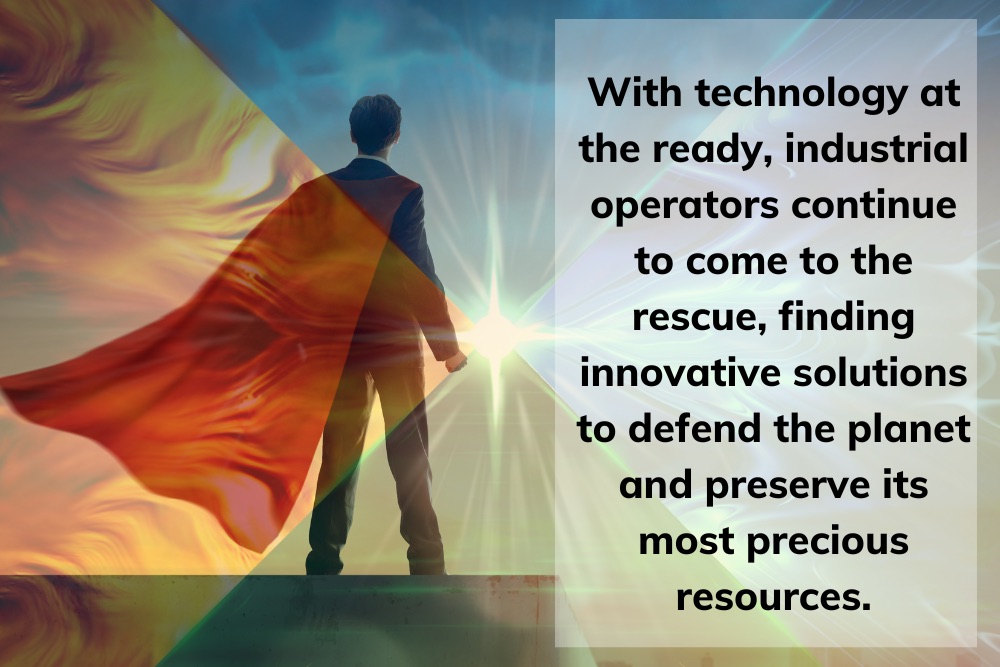
With fresh insight and excitement for the year ahead, the FreeWave leadership team discusses their vision for the future, predictions about the evolution of data, and collective approach to protecting life’s essentials. Though you might not find their names in the next Marvel film or DC comic book, industrial leaders – whether in agriculture, energy, utilities, or another resource industry – are the heroes of the modern world, real-life Guardians of the Galaxy, if you will. These heroes fight today’s challenges every day, while life’s essentials like food, air, energy, and water are threatened daily. With technology at the ready, industrial operators continue to come to the rescue, finding innovative solutions to defend the planet and preserve its most precious resources. At FreeWave, our goal is to continually build upon technology advancements to help you build a better world within your industry. With 2023 right around the corner, we asked four of FreeWave’s senior leaders, including Kirk Byles (CEO), Michael Tate (COO), Parthesh Shastri (CTO), and Jeff Horton (CRO) to share their thoughts on how FreeWave Technologies is helping the heroes of today protect life’s essentials to create a better tomorrow. ___________________________________________________________________ Q: What is one of your favorite FreeWave memories from this past year? Kirk Byles: It’s hard to even remember before this quarter, but the Reinke Dealer Conference was definitely a top highlight for me this year. Not only did it show the work our collective teams have been doing to build relationships and finalize a new product offering, but it was also really cool to see the impact our work is having in real-time, as we partner with Reinke – one of the largest pivot irrigation manufacturers in the world – to help growers and producers save water and raise crops. This was really big. Parthesh Shastri: This year, we really came together across disciplines within FreeWave, too, increasing our focus on target outcomes to deliver products that our customers use and deploy in the field, and we had a lot of fun while doing it! As we look at 2023, we are excited to scale this model and implement it across new industries. Q: How is FreeWave helping industrial operators protect life’s essentials? Jeff Horton: The top thing that comes to my mind is bringing automation to irrigation. We work closely with our partners, like Reinke, to provide real-time analytics, which saves a lot of water and nutrients, and both of these things are invaluable for farmers. Technology also helps to reduce fuel consumption on ranches by eliminating the need to manually check cattle watering tanks. Some producers often spend 12 to 15 hours a week driving around just to look at their water tanks. Think about the wear and tear on those pickup trucks or even the rising cost of fuel. Being able to reduce greenhouse gas and save these guys money while also producing a high return on investment is a really big deal. We can do that easily with the Tank Level Monitor. Mike Tate: And it’s not just the ROI. These producers are suffering. Ranching is not the lucrative business that it once was, and these ranchers are getting beaten at every turn. A lactating cow needs one gallon of water for every hundred pounds, every six hours! Water is a huge concern for both producers and growers, and being able to give them back more time while reducing their expenses is a great value add because every dollar counts for them. Q: Is the word “efficiency” changing for industrial operators? Jeff: When you look at conditions today, both here in the United States and globally, you see so many labor shortages, droughts, inflation, and climate changes, and it’s forcing efficiency, not for efficiency’s sake, but for sustainability and survivability. Businesses have to fundamentally change the way they produce a product, and they have to find the least expensive, most efficient path to go to market. Efficiency isn’t an option anymore; it’s a necessity. Kirk: For years, everybody has wanted to do more with less, and usually, there’s some sort of limitation in the way until someone invents a solution that takes things to the next level. That’s what we’re all about at FreeWave. We’re not doing anything necessarily earth-shattering; but we are innovating. We’re providing a mechanism for our customers to become more and more operationally efficient – to increase their bottom line – and make things better, and not just for their business, but for their employees and life, in general. Case in point: oil and gas companies, considered by some to be big polluters. However, these companies have many sustainability and environmental initiatives and tenants they strive to uphold. They are a critical component of our everyday lives. They’re evolving and innovating, too. FreeWave, helps them get the most out of the equipment they have on-site so that they’re more effectively getting the oil and gas out of the ground with minimal impact. Overall, a more efficient company means less impact on the environment, and these kinds of solutions help create a better planet. Q: In your wildest imagination, where can technology take the industrial leader in the next ten years? Parthesh: There are so many great examples. In China, there’s currently a 12-story tall facility being built to raise hogs in a conditioned environment. It’s like an office space for swine. In this environment, technology is being used in such a way that human intervention is really minimized, and because most things are entirely data-driven, they are able to be a lot more efficient. Now, there are pros and cons to what’s taking place there, and we won’t know the final outcomes for a while, but the march of technology is going to continue to go on, and I believe we will continue to see a lot more practices like this in the future. Jeff: Another example is indoor growing facilities in Saudi Arabia and Qatar. Massive facilities that are purpose-built for farming simply because there is
The Unlikely Marriage of Sustainability and IIoT
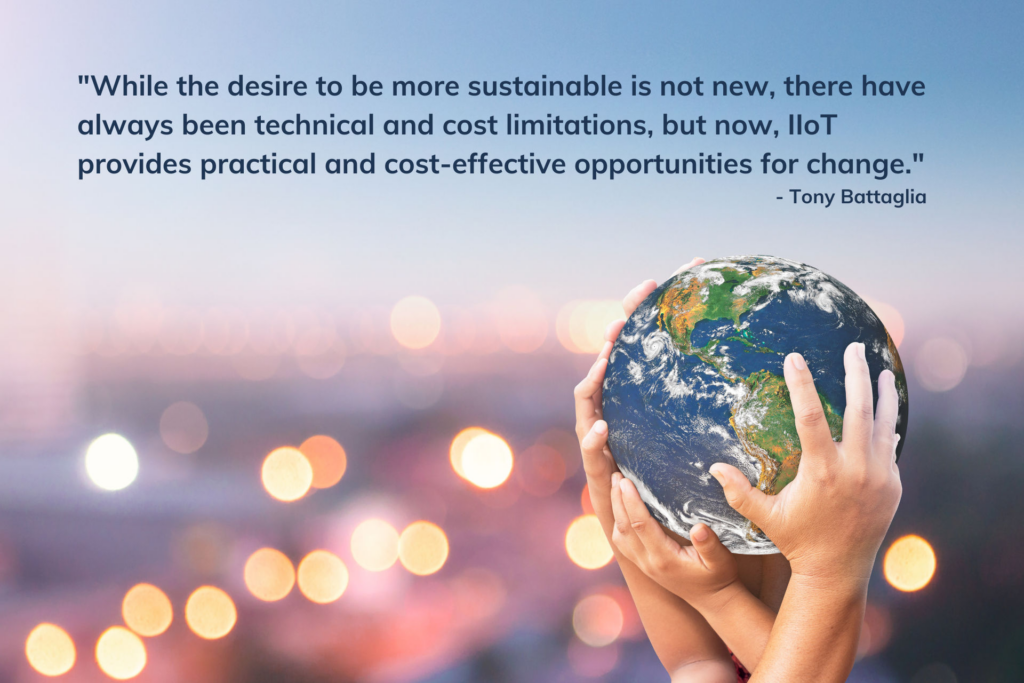
When I think about technology’s impact on sustainability, I think about home. I live in California, and earlier this year there was a fire in my area which, unfortunately, destroyed a lot of houses and affected many families. Luckily, because my city deployed industrial internet of things (IIoT) solutions for fire protection services, they were able to detect this fire early on and prevent further damage in the area. In this scenario, IIoT solutions provided timely insights which allowed the appropriate resources to respond faster, creating a better and safer future for my community. The unlikely pair Sustainability is a widespread conversation these days, and for good reason – a more environmentally conscious world equals better quality of life for us all. As such, electric cars are on the rise, paper straws are everywhere and many companies are doing their part to minimize their carbon footprint. As a collective, we are making great strides in our attempt to create more eco-friendly communities. Amidst our best efforts, however, many may not realize the positive and profound role modern technology, specifically IIoT, can have on our journey towards a greener society. This may come as a surprise, but now more than ever, IIoT is playing a key role in realizing our sustainability goals. Real-world change Today, IIoT technology is completely enhancing our approach to transformative environmental practices by providing the power of response. By implementing IIoT into our data, we can do much more than just monitor data; we can actually respond to data by pulling trends, sending out alerts, leveraging artificial intelligence and so much more. IIoT allows us to take data-driven action, and this is ultimately having a significant impact on the environment and entire industries across the globe. Industry-wide impact In 2015, The United Nations Member States all adopted the 2030 Agenda for Sustainable Development. This global partnership calls countries into action to create a stronger planet by implementing eco-friendly strategic practices to achieve 17 different Sustainable Development Goals (SDGs). Technology plays a significant role in realizing these SDGs. In fact, there are a variety of industries becoming more sustainable because of IIoT. Let’s look at energy, for example. Recently, the energy space began implementing environmental and social governance (ESG) criteria. Now, different organizations can receive access to various federal funds depending on their ability to meet ESG standards. Without the use of IIoT practices, procedures and functions, these organizations could not make the improvements needed to contribute to their environmental goals. With the use of IIoT, these same companies can effectively monitor and manage environmental assets through automated procedures that contribute to more efficient industries and remote work environments across the board. Ultimately, IIoT technology offers the insight and practical solutions needed for these companies to create positive structural changes. The benefits don’t stop there. We’ve all heard or read that our water supply is endangered, and this is not just a California issue, like many assume; it’s a widespread problem that needs immediate attention. The rapid rate of water decrease is not just a byproduct of human consumption, it is also a direct result of everyday processes, industrialization and the ever-changing climate. Today, IIoT products are providing simple solutions to monitor timely data metrics like rainfall rate and water consumption. These solutions respond to water shortages and water waste in innovative ways. Through IIoT, we now have the ability to adjust and adapt our behaviors based on data visualizations, and throughout the process, greater sustainability is achieved worldwide. The IIoT difference on finite resources With sustainability, the goal is really to manage the lifespan of an existing asset, be it drinking water, livestock, oil and gas, the list goes on, and with IIoT technology, we can better control our ability to manage these assets. While the desire to be more sustainable is not new, there have always been technical and cost limitations, but now, IIoT provides practical and cost-effective opportunities for change. At FreeWave Technologies, we’re committed to improving life’s essentials through Industrial IoT solutions. Our full line of connected IIoT network solutions bring most needed data to operations teams wherever they are and our ready-to-deploy solutions play a significant role in environmental monitoring ultimately leading to safer and more sustainable communities. When it comes to Environmental IoT™ we are spearheading a new way forward, offering solution-based products that empower industrial leaders to manage their assets simply and intentionally. Our single pane of glass dashboard creates a singular view for our customer, allowing them to track, control and respond to timely data metrics in one place instead of multiple dashboards across applications. Products that solve problems are important, and that’s exactly what we’re providing at FreeWave. We’re shifting the culture of sustainability from altruism to action, and it’s making a substantial difference. At the end of the day, I care about the world that I’m leaving for the next generation. Every day I think about my two children and the world they’ll grow up in; I want to do my best to create a place where they can thrive, and I’m excited to be a part of an organization that is achieving just that.
Technology’s Impact on Air Quality Control Monitoring
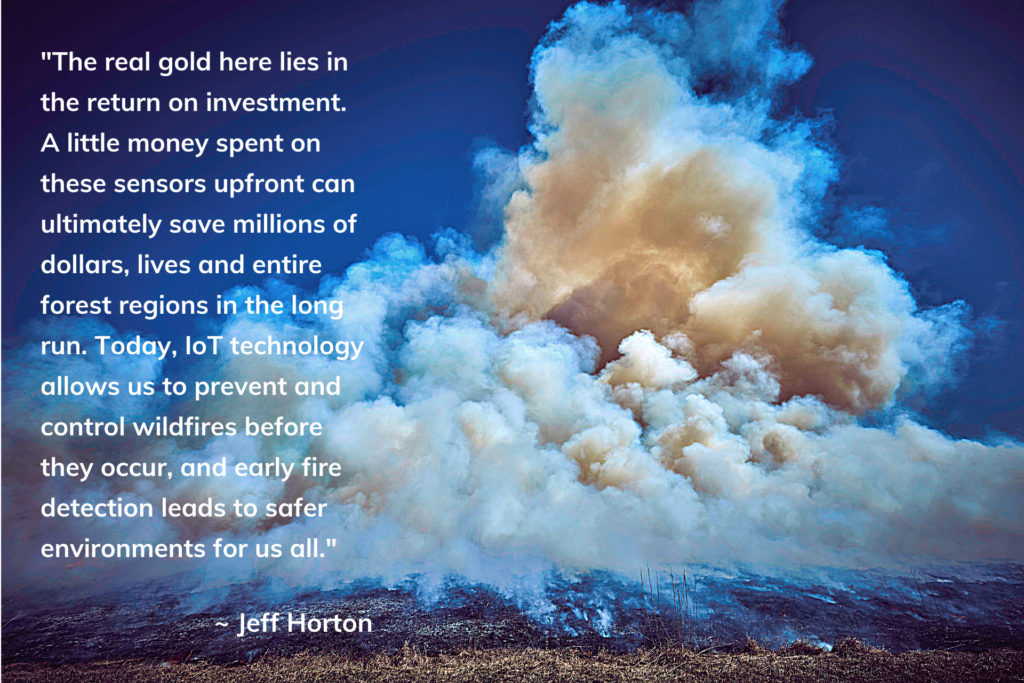
At this very moment, wildfire season is currently underway in North America, and since the start of this year alone, more than 27,000 wildfires have consumed nearly two million acres according to the National Interagency Fire Center (www.nifc.gov). Though many people hear the word “wildfire” and immediately picture a forest in California, the reality is these natural disasters are prevalent across the country. Wildfires are everywhere The Verge, a technology news website, announced recently that roughly 56% of homeowners in the United States face some sort of wildfire risk in the upcoming decades. Bottom line: wildfires are becoming more prevalent and costly every day, and these fires are affecting more than half the population and significantly changing our quality of life. Just a few decades ago, we didn’t have the technology to prevent or predict changes in the surrounding air quality, but now we do, and through it, we can create a better world. Today’s technological advancements allow us to be proactive rather than reactive when it comes to our overall health and safety. By leveraging sensor technology, we have a better chance of predicting and preventing significant changes in the environment, like a drastic shift in air quality before a wildfire begins. This insight allows us to make better decisions based on intentional insights, and our increased access to data provides us with the right information to better control our surrounding environments. Technology is powerful, and this power can and should be used to our advantage. One of my favorite ways to witness the power of technology transforming real-world issues is by exploring the ways sensor technology has a tremendous impact on air quality control monitoring. Today, internet of things (IoT) technology and satellite are the best tools for early detection and prevention of wildfires. Our approach to air quality control Believe it or not, air quality has as much impact on the world as the daily temperature. With climate change causing drastic shifts in the environment, it’s important that we pay close attention to the quality of the air we breathe, as it affects our overall quality of life. As you know, trees play a critical role in our ecosystem, so we must be very intentional and proactive about protecting the forests around us. This is where sensor technology makes a big difference. With a small machine, we can now track and predict changes in the environment and our surrounding air quality, which ultimately helps us control, prevent and predict conditions that lead to wildfires. At FreeWave, we provide autonomous sensors that are strategically placed in remote locations to track and record relevant data metrics such as temperature, humidity, wind, direction and particulate matter. These readings help industry experts know what’s in the air and how the air is changing. Once this data is collected and transmitted to the cloud, we are then able to analyze it and provide alert and proactive responses where needed. We have created a single pane of glass approach, where anyone with access can log into a portal and see in real-time what is happening in the areas surrounding their deployed sensors. The interesting thing about our sensors is that they are fully powered by solar energy, and satellite signals transmit the recorded data. We are basically offering a “buy, install and forget” resource that makes life significantly easier for industry and environmental experts. There is a ton of value here. Not only are we taking an in-depth look at what’s going on in the environment through air quality control monitoring, but we are also taking that information and transforming it into action. The real gold here lies in the return on investment. A little money spent on these sensors upfront can ultimately save millions of dollars, lives and entire forest regions in the long run. Today, IoT technology allows us to prevent and control wildfires before they occur, and early fire detection leads to safer environments for us all. A unique human aid We are making life simpler and safer for all by using technology to do what humans can’t. Back in the day, people had to sit in an operation tower for hours, looking out to catch any major changes in the environment. Today, there is a major shortage of people willing to do this kind of work, and can you blame them? As humans, we can only be in one place at a time doing one thing at a time, but with technology, this is not the case. With simple sensors, we can now monitor and control a lot more environments at a much more affordable rate. All this to say, the goal here is not to replace humans with technology as some might think; what we are really doing is enhancing human ability through the power of technology. I’ve worked in technology for over 30 years, and every day I witness its evolution. I know it’s hard to imagine a world without cell phones, but I can still clearly recall the days when cell phones took up the entire trunk of a car, and now look at the world, most of us carry the same ubiquitous smartphone in our pockets. Technology is amazing, and we have the opportunity to use it to our advantage. At FreeWave, we are taking the capabilities of mobility – LTE, 4G, Satellite, Wi-Fi, Bluetooth, 900 MHz– and marrying them with sensors. The data we gain from these sensors is saving us time, money and resources. At the end of the day, we’re taking away the need to “overthink” industry issues, like how to better prevent forest fires, and instead are replacing our questions with data-informed predictions and timely proactive responses. Every day, we strive to provide industry leaders with the tools and technology needed to spearhead faster and safer environments for us all. This is certainly not a boring business, and I thoroughly enjoy working for a company that is using technology to have an impact on the things that matter most.

